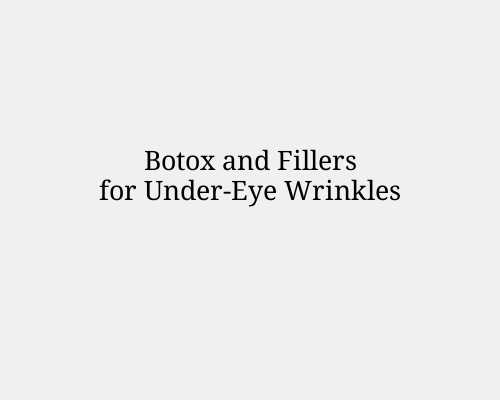
Botox and Fillers for Under-Eye Wrinkles: Risks, Results, and Recovery
Under-eye wrinkles are a common concern as we age. These fine lines and creases develop due to thinning skin, loss of elasticity, decreased collagen production, sun damage, and repetitive facial expressions. While skincare and lifestyle changes can help, many people seek more immediate and noticeable results with cosmetic injectables like Botox and dermal fillers. This article provides a balanced overview of Botox and fillers for treating under-eye wrinkles, including how they work, potential risks, expected results, and essential pre- and post-treatment care.
Understanding the Problem: Why Under-Eye Wrinkles Form
The skin under the eyes is thinner and more delicate than the rest of the face. Over time, this area shows early signs of aging due to:
Reduced collagen and elastin production
Dehydration and lack of fat padding
Dynamic movement from squinting or smiling
Environmental damage (especially from UV exposure)
Genetic predisposition
Addressing these wrinkles often requires more than topical treatments, which is where injectables come in.
Botox for Under-Eye Wrinkles What It Is:
Botox (botulinum toxin type A) is a neuromodulator that temporarily relaxes the muscles responsible for repetitive facial expressions. By doing so, it smooths dynamic wrinkles caused by motion.
How It Works Under the Eyes:
Botox can be injected into the orbicularis oculi—the muscle surrounding the eye—to reduce the
appearance of wrinkles formed when squinting or smiling (commonly known as “crow’s feet” and lower lid wrinkles).
Pros of Botox for Under-Eye Wrinkles
Quick procedure (typically 10–20 minutes)
Minimal downtime
Effective for dynamic wrinkles
Results appear in 3–7 days
Can prevent wrinkles from deepening over time
Cons of Botox
Not effective for deep or static wrinkles caused by volume loss
Risk of temporary drooping or puffiness if injected improperly
Results last 3–4 months; requires regular maintenance
Off-label use under the eyes means not FDA-approved for that specific area
Risks and Side Effects
Bruising, swelling, and tenderness at the injection site
Temporary under-eye heaviness or asymmetry
Headache or flu-like symptoms (rare)
Risk increases with inexperienced injectors
Dermal Fillers for Under-Eye Wrinkles What They Are:
Fillers like hyaluronic acid (HA) products (e.g., Restylane, Juvederm) are gel-like substances injected to add volume and hydration. In the under-eye area, they can fill hollows, smooth fine lines, and improve skin texture.
How They Work:
Dermal fillers address volume loss under the eyes, which can create shadows and make wrinkles more noticeable. They’re often used in the “tear trough” area to provide a smoother contour.
Pros of Fillers
Immediate visible results
Long-lasting (typically 6–12 months)
Can treat both wrinkles and under-eye hollows
Most HA fillers are reversible with hyaluronidase
Cons of Fillers
Not effective for dynamic wrinkles caused by muscle movement
Technique-sensitive: poor injection can cause lumps, bluish tint (Tyndall effect), or uneven texture
Higher cost per treatment compared to Botox
Possible need for touch-ups or correction
Risks and Side Effects
Swelling, bruising, and tenderness
Lumps or uneven distribution of product
Tyndall effect (bluish discoloration under thin skin)
Rare but serious complications like vascular occlusion
Choosing the Right Option
Whether Botox or fillers are appropriate depends on the type of wrinkles and individual anatomy:
Fine lines from movement: Botox is typically more effective.
Hollowing or volume loss: Fillers are better suited.
Mixed concerns: A combination of Botox and filler (done strategically) may be ideal.
A board-certified dermatologist or experienced injector will evaluate skin quality, muscle movement, and volume loss to determine the best approach.
Pre-Treatment Care
To minimize complications, follow these guidelines before your appointment:
Avoid alcohol, aspirin, NSAIDs, and supplements like fish oil or vitamin E for 5–7 days before treatment to reduce bruising
Stay well-hydrated
Inform your provider of any medications or medical conditions
Discuss realistic goals and expectations
Post-Treatment Recovery and Care After Botox:
Avoid lying down, exercising, or rubbing the treated area for at least 4 hours
Results begin to show in 3–7 days, with full effect in 2 weeks
Minimal downtime—most people return to normal activities immediately
After Fillers:
Apply cold compresses to reduce swelling and bruising
Avoid vigorous exercise, alcohol, and saunas for 24–48 hours
Sleep with your head elevated for the first night
Wait 1–2 weeks to see full results, as swelling may obscure the outcome
Realistic Expectations: Before and After
While Botox and fillers can improve the appearance of under-eye wrinkles significantly, they are not permanent fixes or substitutes for surgical procedures in severe cases. For mild to moderate wrinkles, the results are often subtle but noticeable—a refreshed, less tired look.
Before and after images (usually provided by your injector) can help you understand what to expect, but keep in mind that results vary based on skin type, age, lifestyle, and injector skill.
Final Thoughts
Botox and dermal fillers offer effective, minimally invasive solutions for under-eye wrinkles when performed by skilled professionals. However, they carry risks—especially in this delicate area. Choosing a qualified provider is essential to achieving natural-looking results and minimizing complications. While injectables are not miracle cures, they can be part of a successful anti-aging strategy when combined with good skincare, sun protection, and healthy lifestyle habits.